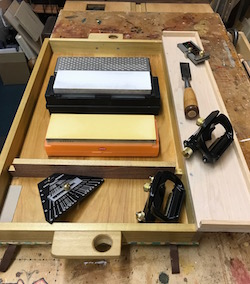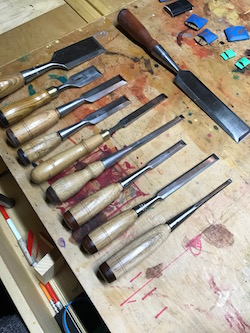Oh those tools! If you added a chisel to your tool kit and used it… and used it… and used it, you are wondering why it takes more effort to push the tool along the wood. Is it slipping and getting dangerously close to cutting flesh? Maybe it already has… ouch!
It all means that the tool blade is dull. That makes it a hindrance to working safely and efficiently. It is time to regain the sharp edge that makes your work a joy. Yes, it is sharpening time. Ah! The light of realization sparked, didn’t it? Catch up sharpening is a constant in shop life, oh no! And there is a bunch of it to do!
I have a number of old chisels that I’ve refurbished. In my kit, an extra one or two in the most used sizes, 1/2″ and 1″, are always ready to be picked up. When one of those chisels gets dull, I have a spare to continue my work until I am ready to take time out to sharpen.
Oil and water do not mix
The sharpening stones that I use, ceramic glass water stones, are sometimes simply referred to as ceramic water stones. I use both.
In referencing ceramic water stones, I am emphasizing the “no-soak” feature of both. They do not require long-term soaking in water and the associated extra efforts. For more clarity on sharpening options, click here.
I use ceramic glass water stones because of their beauty. The finely textured stone affixed to a thick glass plate embodies a changing attitude toward sharpening. It is the final break from any feeling of obligation to use traditional oil stones as evidence of woodworking proficiency.
For me, ceramic water stones are cleaner and compelling. I am compelled to use them! That’s the only reason I need.
Break any Rule
My real concern is maintaining a sharp blade. Like most rules, guidance for blade angles on chisels and planes should be learned first. Then I give myself permission to break the rules. That action is taken after I find that what I am doing is not working for me.
Further along my woodworking journey, I have found that there is no definitive agreement on sharpening. Angles for grinding, honing, and special circumstances have been the subject of spirited debates. Sharpening to a highly polished level is deemed unnecessary by some. I’ve witnessed many of those discussions.
Wood mask carver, LaCharles James, summed up the requirements by observing that tools are geared to taking away wood accurately, easily, and safely.
That observation helped relieve a lot of my stress about sharpening.
I don’t adhere to very strict guidelines because once the tool hits the wood, I make the adjustments I need.

blade angles during the sharpening process.
I don’t use oil stones
Oil stones have not become obsolete. But the concept of using water instead of oil on any stone gave many people permission to try something different.
The timing was right for me when I really got serious about woodworking. I have collected a few oil stones and could use them when I want.
However, the oil stone was never something I could really master or wanted to. They were “slow” and I did not know anyone who could show me how to use them. They were slippery and messy to me.
I don’t want to be cold either
Traditional long soaking water stones did not appeal to me either. Working in a cold garage in the winter time with submerged water stones was not my favorite thing to do. Reaching into a bucket of bone chilling cold water is, well… bone chilling. Thus, I put off any serious catch up sharpening until the weather got warmer.
Ceramic water stones’ splash and go feature – no soaking – is the number one appeal. Yes, I am repeating myself. I don’t like the cold.

Now, I have a set up that works for me. I am still discovering how each grit works on my blades, mostly A2 steel and vintage blades from tools I refurbished.
This steel class, A2, sharpens to a tough, more durable edge, but requires a small workout to get there. Sometimes a vintage tool blade turns out to be a “mystery” tool steel that will not yield easily to the stone. This calls for a little help. For most blades, however, I can achieve a sharp edge and use it for a long time before returning to the stone or strop.
Finding sharpening flow
Catch up sharpening might be unavoidable but does it have to be unpleasant? Let’s approach it in another way. Make it your “wax on, wax off” moment every time.
A daily, weekly, or monthly sharpening routine is woodworking training. Consider it a serious opportunity to:
- develop muscle memory,
- practice breathing,
- build up wrist/hand control,
- expand patience.
Staging tools and making a special time just for inspecting and sharpening is relaxing. Does that sound incredulous? I believe that sharpening certainly should be a part of woodworking that I enjoy not endure.
Rushing through that process defeats the purpose of finding the flow and slowing down even during catch up sharpening.

Fortunately, I have a few old chisels and blades so I’m not relying on any one tool. I guess I really don’t need to rush.
Baadaye.*
* later (in Swahili)
💙S

